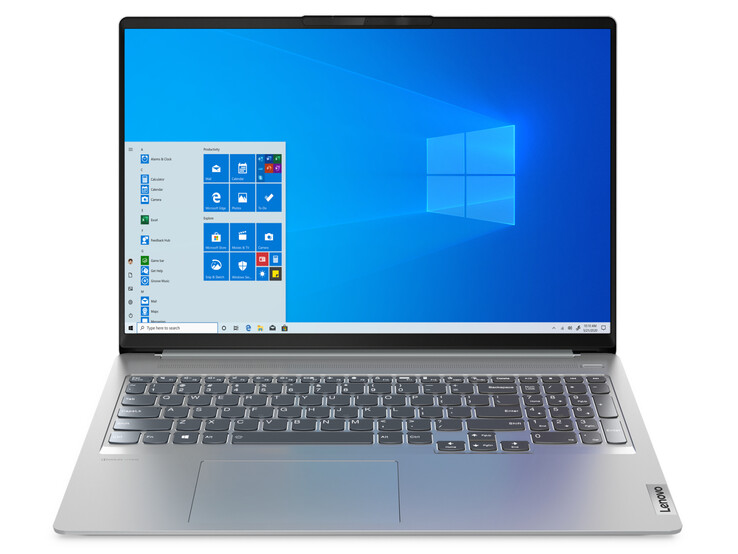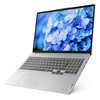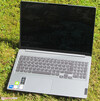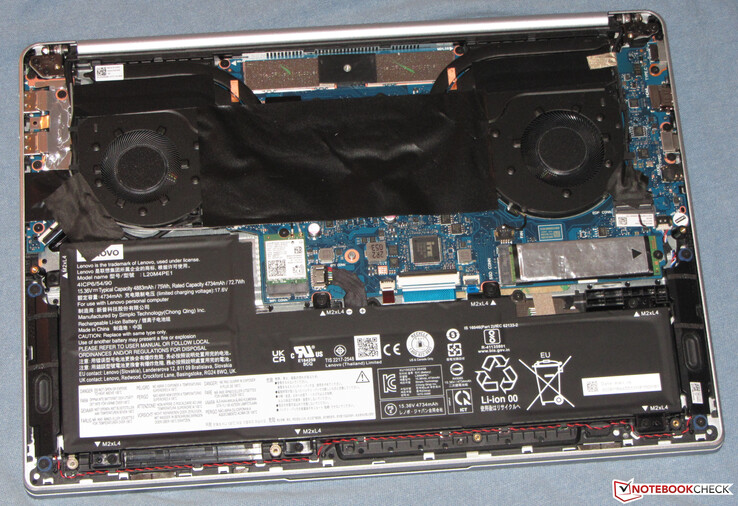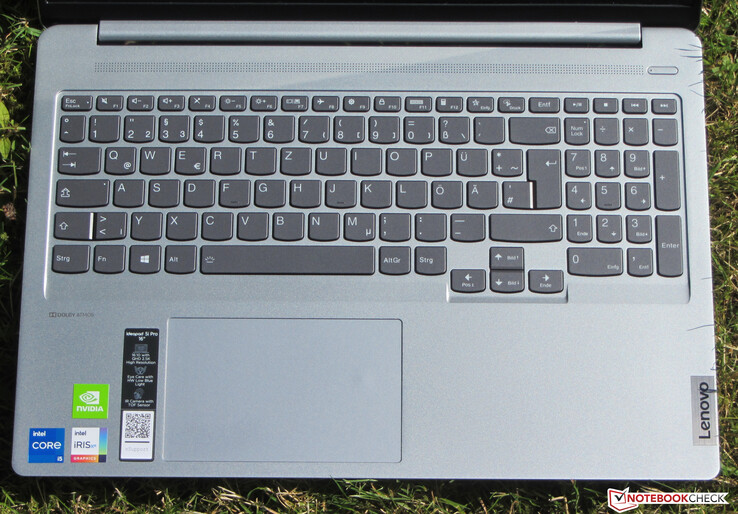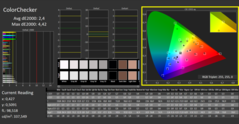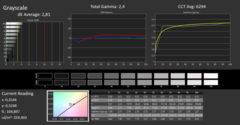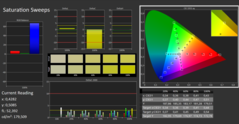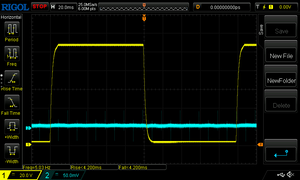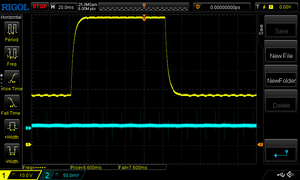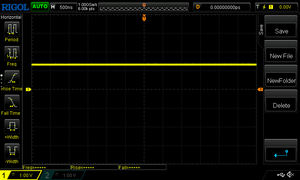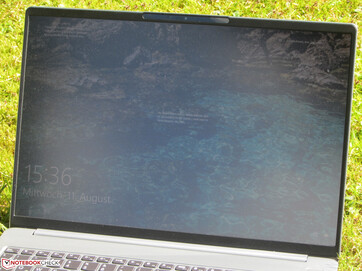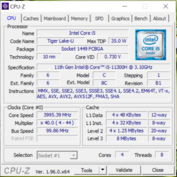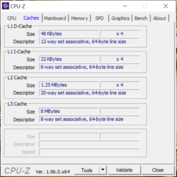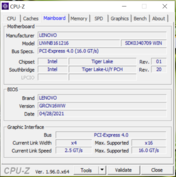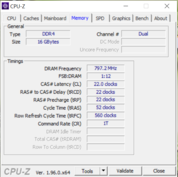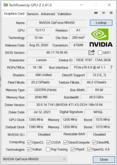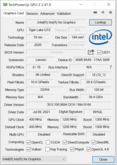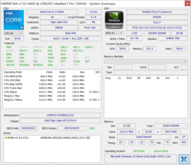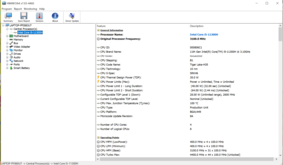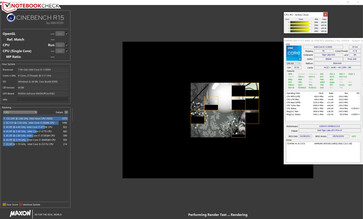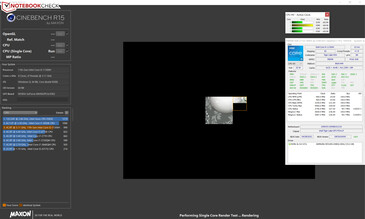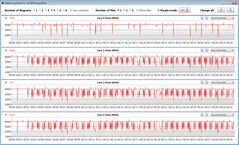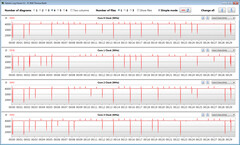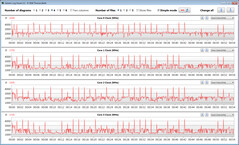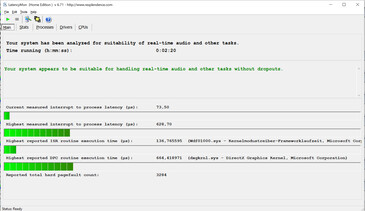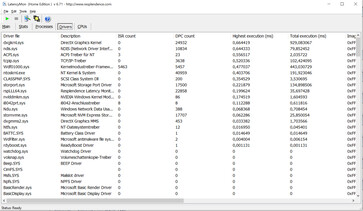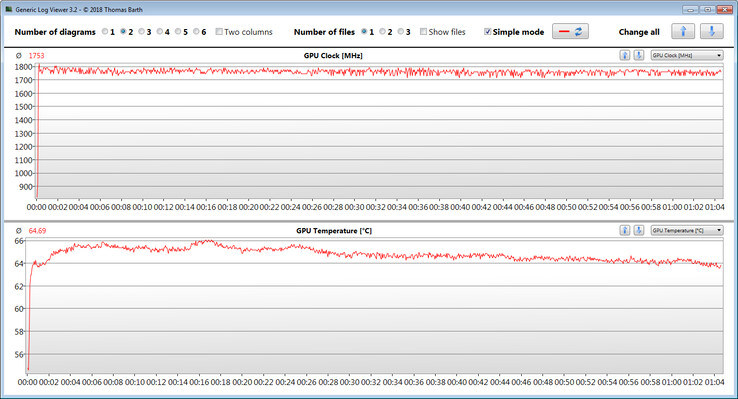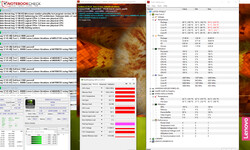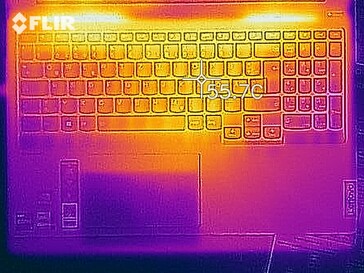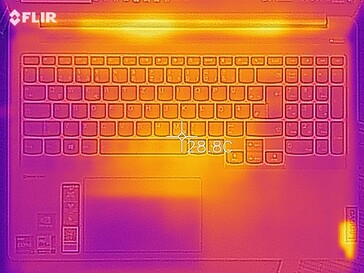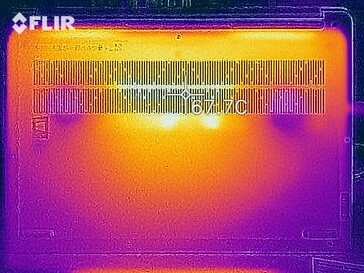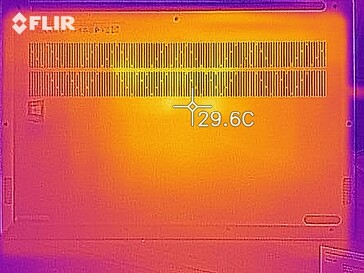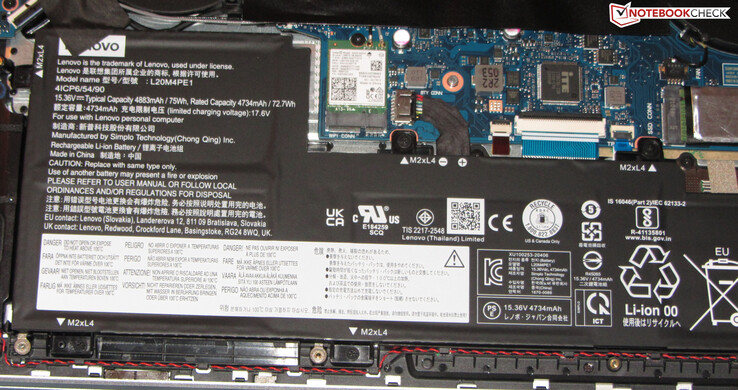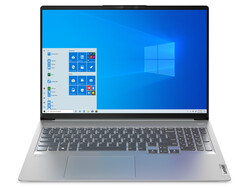Lenovo IdeaPad 5 Pro 16IHU6 in review: 16-inch all-rounder with good battery life

With the IdeaPad 5 Pro 16IHU6, Lenovo has a stylish all-rounder in its lineup that is powered by a Core i5-11300H processor and a GeForce MX450 GPU. One of the laptop's highlights is its 16-inch display in the 16:10 format. Competitors include devices like the Xiaomi RedmiBook Pro 15, the Huawei MateBook D 16, and the HP Pavilion 15.
Possible contenders in comparison
Rating | Date | Model | Weight | Height | Size | Resolution | Price |
|---|---|---|---|---|---|---|---|
| 86 % v7 (old) | 08 / 2021 | Lenovo IdeaPad 5 Pro 16IHU6 i5-11300H, GeForce MX450 | 1.9 kg | 18.4 mm | 16.00" | 2560x1600 | |
| 81.2 % v7 (old) | 06 / 2021 | HP Pavilion 15-eg i7-1165G7, GeForce MX450 | 1.7 kg | 17.9 mm | 15.60" | 1920x1080 | |
| 83.2 % v7 (old) | 06 / 2021 | Xiaomi RedmiBook Pro 15 i7-11370H, GeForce MX450 | 1.7 kg | 16 mm | 15.60" | 3200x2000 | |
| 86 % v7 (old) | 04 / 2021 | Huawei MateBook D 16-53011VFJ R5 4600H, Vega 6 | 1.7 kg | 18.4 mm | 16.10" | 1920x1080 |
Case - The IdeaPad 5 comes with a slim aluminum case
The IdeaPad's slim aluminum case comes in a matte, silver-gray color (Cloud Gray). The display bezel is black. Lenovo has opted for a stylish, no-frills design with smooth surfaces. The laptop doesn't have a maintenance hatch, and the battery is firmly built into the device.
The 16-incher shows a good build quality. The gap dimensions are accurate, and there are no material protrusions. Rigidity and stability leave no room for criticism. The lid and base unit can be twisted a bit, but the whole situation still remains within limits. The hinges hold the lid firmly in position, but they allow it to wobble a bit. The maximum aperture angle is about 155 degrees. Moreover, opening the lid with one hand is possible.
Despite the different display formats and sizes, the devices in our comparison field don't differ too much in terms of dimensions. The IdeaPad weighs about 1.9 kg, a good 200 grams more than the competition.
Connectivity - Lenovo's 16-incher comes with Thunderbolt 4
Lenovo equips the IdeaPad with two USB-A slots (USB 3.2 Gen 1) and two USB-C slots (1x Thunderbolt 4/USB 4.0, 1x USB 2.0). The included power adapter can be connected to both USB-C ports; the USB-C 2.0 port has been primarily intended for this by Lenovo. As a result, the Thunderbolt 4 slot remains available for other things (docking station, external GPU). The latter supports DisplayPort via USB-C. Along with the HDMI output, there are consequently 2 video outputs.
The ports are located in the rear areas of both sides. The space next to the palm rest remains free of cables. It would've been ideal if Lenovo had placed one USB-C and one USB-A port, respectively, on each side of the device.
SD card reader
With transfer rates of 90.6 MB/s (copying large data blocks), the memory card reader (reference card: AV PRO microSD 128 GB V60) is among the fastest models. A comparison with the rates of the Dell XPS 15 makes it clear that much more would be possible. Moreover, the reader doesn't accommodate SD cards completely. They protrude a good 17 mm.
| SD Card Reader | |
| average JPG Copy Test (av. of 3 runs) | |
| Dell XPS 15 9560 (i7-7700HQ, UHD) (Toshiba Exceria Pro SDXC 64 GB UHS-II) | |
| Average of class Multimedia (21.1 - 198, n=44, last 2 years) | |
| HP Pavilion 15-eg (AV PRO microSD 128 GB V60) | |
| maximum AS SSD Seq Read Test (1GB) | |
| Dell XPS 15 9560 (i7-7700HQ, UHD) (Toshiba Exceria Pro SDXC 64 GB UHS-II) | |
| Average of class Multimedia (27.4 - 262, n=44, last 2 years) | |
| Lenovo IdeaPad 5 Pro 16IHU6 (AV PRO microSD 128 GB V60) | |
| HP Pavilion 15-eg (AV PRO microSD 128 GB V60) | |
Communication
The WLAN chip (Intel AX201) supports the 802.11a/b/g/n/ac/ax standards and offers Bluetooth 5 functionality. In addition, the data rates determined under optimal conditions (no other WLAN devices nearby, short distance between laptop and server PC; router: Netgear Nighthawk AX12) are very good.
Webcam
In terms of quality, the webcam (0.9 MP, max. 1280x720 pixels) in the Lenovo laptop isn't able to stand out from the cameras of the contenders. Things are better when it comes to color accuracy: With a deviation of around 8, the target (DeltaE less than 3) is clearly missed, but the competition is (narrowly) beaten.
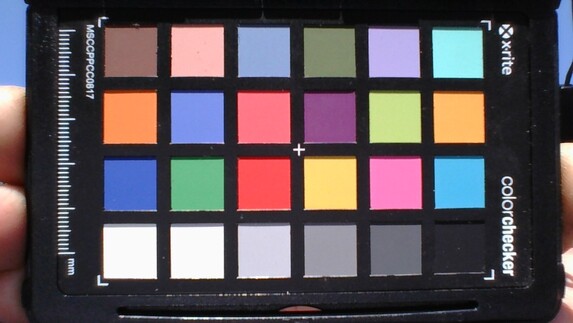
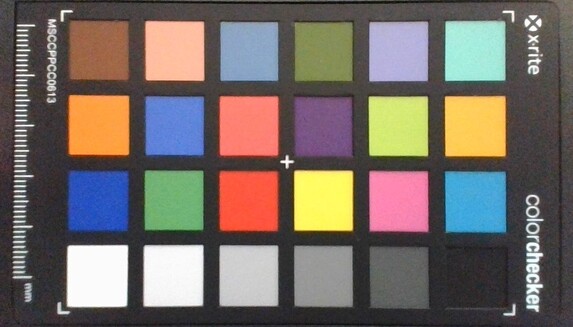

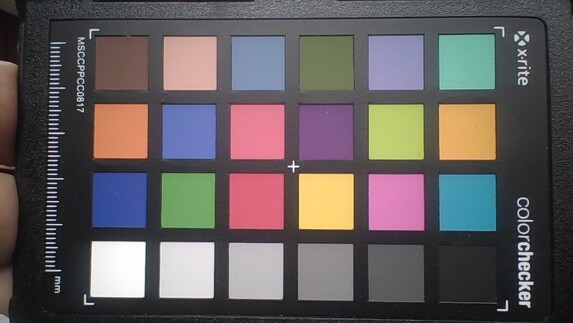
Accessories
The usual documents are included with the laptop: A quick-start guide and warranty information.
Maintenance
The hardware can be accessed after removing the bottom cover. All screws on the underside of the device have to be removed for this purpose. Afterwards, the bottom cover can be lifted off with the help of a flat spatula or a joint smoother. You can then access the SSD, the WLAN module, the BIOS battery, the battery, and the fans. The RAM is firmly soldered.
Warranty
Lenovo grants the 14-incher a two-year warranty in Germany. Furthermore, warranty extensions are available. For example, a four-year on-site warranty costs about 121 Euros (~$142).
Input devices - The Lenovo laptop has a backlit keyboard
Keyboard
Lenovo equips the IdeaPad with a backlit chiclet keyboard (including a number pad). The smooth, flat keys have a short travel and a clear stroke. The resistance provided by the keys is pleasing. Moreover, the keyboard yields a bit during typing. It didn't prove to be bothersome, though. The two-stage backlight is controlled via a function key. All in all, Lenovo delivers a keyboard that is suitable for everyday use.
Touchpad
Display - IPS in the 16:10 format
| |||||||||||||||||||||||||
Brightness Distribution: 80 %
Center on Battery: 356 cd/m²
Contrast: 1319:1 (Black: 0.27 cd/m²)
ΔE ColorChecker Calman: 2.4 | ∀{0.5-29.43 Ø4.79}
ΔE Greyscale Calman: 2.81 | ∀{0.09-98 Ø5}
74.5% AdobeRGB 1998 (Argyll 3D)
98.7% sRGB (Argyll 3D)
74% Display P3 (Argyll 3D)
Gamma: 2.4
CCT: 6294 K
| Lenovo IdeaPad 5 Pro 16IHU6 Lenovo LEN160WQXGA, IPS, 2560x1600, 16" | HP Pavilion 15-eg Chi Mei CMN1523, IPS, 1920x1080, 15.6" | Xiaomi RedmiBook Pro 15 IPS, 3200x2000, 15.6" | Huawei MateBook D 16-53011VFJ N161HCA-EA3, IPS, 1920x1080, 16.1" | |
|---|---|---|---|---|
| Display | -39% | -7% | -6% | |
| Display P3 Coverage (%) | 74 | 42.9 -42% | 66.7 -10% | 66.8 -10% |
| sRGB Coverage (%) | 98.7 | 64 -35% | 96.3 -2% | 99 0% |
| AdobeRGB 1998 Coverage (%) | 74.5 | 44.4 -40% | 68.5 -8% | 69 -7% |
| Response Times | -135% | -184% | -134% | |
| Response Time Grey 50% / Grey 80% * (ms) | 13 ? | 22.8 ? -75% | 34.8 ? -168% | 25 ? -92% |
| Response Time Black / White * (ms) | 8 ? | 23.6 ? -195% | 24 ? -200% | 22 ? -175% |
| PWM Frequency (Hz) | 26320 ? | 2500 ? | ||
| Screen | -59% | -40% | 15% | |
| Brightness middle (cd/m²) | 356 | 294.3 -17% | 312 -12% | 352 -1% |
| Brightness (cd/m²) | 322 | 251 -22% | 298 -7% | 330 2% |
| Brightness Distribution (%) | 80 | 76 -5% | 87 9% | 89 11% |
| Black Level * (cd/m²) | 0.27 | 0.26 4% | 0.18 33% | 0.28 -4% |
| Contrast (:1) | 1319 | 1132 -14% | 1733 31% | 1257 -5% |
| Colorchecker dE 2000 * | 2.4 | 4.08 -70% | 5.39 -125% | 1.35 44% |
| Colorchecker dE 2000 max. * | 4.42 | 19.49 -341% | 9.95 -125% | 2.58 42% |
| Greyscale dE 2000 * | 2.81 | 3 -7% | 6.3 -124% | 2.02 28% |
| Gamma | 2.4 92% | 2.21 100% | 2.192 100% | 2.49 88% |
| CCT | 6294 103% | 6616 98% | 7473 87% | 6445 101% |
| Colorchecker dE 2000 calibrated * | 3.7 | 3.15 | ||
| Color Space (Percent of AdobeRGB 1998) (%) | 69 | 63 | ||
| Color Space (Percent of sRGB) (%) | 96 | 99 | ||
| Total Average (Program / Settings) | -78% /
-66% | -77% /
-54% | -42% /
-13% |
* ... smaller is better
Out of the box, the display shows a good color reproduction and meets the target with a color deviation of 2.4 (Delta E less than 3). It doesn't suffer from a blue tint, either. The sRGB color space is covered by 99%. The AdobeRGB (75%) and DCI-P3 (74%) color spaces can't be fully reproduced by the display.
Display Response Times
| ↔ Response Time Black to White | ||
|---|---|---|
| 8 ms ... rise ↗ and fall ↘ combined | ↗ 4 ms rise | |
| ↘ 4 ms fall | ||
| The screen shows fast response rates in our tests and should be suited for gaming. In comparison, all tested devices range from 0.1 (minimum) to 240 (maximum) ms. » 21 % of all devices are better. This means that the measured response time is better than the average of all tested devices (20.3 ms). | ||
| ↔ Response Time 50% Grey to 80% Grey | ||
| 13 ms ... rise ↗ and fall ↘ combined | ↗ 6 ms rise | |
| ↘ 7 ms fall | ||
| The screen shows good response rates in our tests, but may be too slow for competitive gamers. In comparison, all tested devices range from 0.165 (minimum) to 636 (maximum) ms. » 25 % of all devices are better. This means that the measured response time is better than the average of all tested devices (31.7 ms). | ||
Screen Flickering / PWM (Pulse-Width Modulation)
| Screen flickering / PWM not detected | |||
In comparison: 53 % of all tested devices do not use PWM to dim the display. If PWM was detected, an average of 8167 (minimum: 5 - maximum: 343500) Hz was measured. | |||
Performance - Tiger Lake and Turing
With the IdeaPad 5 Pro, Lenovo has a 16-inch all-rounder in its lineup that provides enough performance for office and Internet applications as well as computer games.
Test conditions
The laptop offers three performance profiles ("Intelligent Cooling", "High Performance", "Battery Saving Mode"), which can be switched between via the key combination "Fn" + "Q". We used the "Intelligent Cooling" profile. In addition, we ran some benchmarks with the "High Performance" and "Battery Saving" profiles active. The results can be found in the comparison tables.
| Battery Saving Mode | Intelligent Cooling | High Performance | |
|---|---|---|---|
| PL1 | 12 watts | 40 watts | 45 watts |
| PL2 | 20 watts | 64 watts | 64 watts |
Processor
The Core i5-11300H quad-core processor (Tiger Lake) runs at a base clock speed of 3.1 GHz. An increase to 4 GHz (four cores) or 4.4 GHz (one core) is possible via Turbo. Hyper-Threading (two threads per core) is supported.
The multithread test of the Cinebench R15 benchmark is processed at 4 GHz, and the single-thread test at 2.2 to 4.4 GHz. The clock rates are lower on battery power.
We verify if the CPU Turbo is also consistently used when plugged in by running the Cinebench R15 benchmark's multithread test in a continuous loop for at least 30 minutes. Turbo is used to a small extent. Moreover, the High Performance profile leads to a slight increase in clock speeds.
The Battery Saving profile allows the CPU to run at speeds well below the base clock rate for a prolonged period of time. Nonetheless, the available processing power is more than sufficient for office and Internet use. Furthermore, the profile has a positive effect on noise and heat development as well as on battery life.
Cinebench R15 Multi endurance test
| Cinebench R23 | |
| Single Core | |
| Average of class Multimedia (1128 - 2459, n=75, last 2 years) | |
| Xiaomi RedmiBook Pro 15 | |
| HP Pavilion 15-eg | |
| Lenovo IdeaPad 5 Pro 16IHU6 | |
| Lenovo IdeaPad 5 Pro 16IHU6 (Hoechstleistung) | |
| Average Intel Core i5-11300H (1218 - 1431, n=11) | |
| Lenovo IdeaPad 5 Pro 16IHU6 (Akkusparmodus) | |
| Huawei MateBook D 16-53011VFJ | |
| Multi Core | |
| Average of class Multimedia (4861 - 30783, n=83, last 2 years) | |
| Huawei MateBook D 16-53011VFJ | |
| Lenovo IdeaPad 5 Pro 16IHU6 (Hoechstleistung) | |
| Lenovo IdeaPad 5 Pro 16IHU6 | |
| Xiaomi RedmiBook Pro 15 | |
| Xiaomi RedmiBook Pro 15 | |
| Average Intel Core i5-11300H (3313 - 6581, n=10) | |
| HP Pavilion 15-eg | |
| Lenovo IdeaPad 5 Pro 16IHU6 (Akkusparmodus) | |
| Cinebench R20 | |
| CPU (Single Core) | |
| Average of class Multimedia (420 - 853, n=65, last 2 years) | |
| Xiaomi RedmiBook Pro 15 | |
| HP Pavilion 15-eg | |
| Lenovo IdeaPad 5 Pro 16IHU6 | |
| Lenovo IdeaPad 5 Pro 16IHU6 (Hoechstleistung) | |
| Lenovo IdeaPad 5 Pro 16IHU6 (Akkusparmodus) | |
| Average Intel Core i5-11300H (431 - 548, n=11) | |
| Huawei MateBook D 16-53011VFJ | |
| CPU (Multi Core) | |
| Average of class Multimedia (1887 - 11924, n=65, last 2 years) | |
| Huawei MateBook D 16-53011VFJ | |
| Lenovo IdeaPad 5 Pro 16IHU6 (Hoechstleistung) | |
| Lenovo IdeaPad 5 Pro 16IHU6 | |
| Xiaomi RedmiBook Pro 15 | |
| Average Intel Core i5-11300H (1300 - 2533, n=10) | |
| HP Pavilion 15-eg | |
| Lenovo IdeaPad 5 Pro 16IHU6 (Akkusparmodus) | |
| Cinebench R15 | |
| CPU Single 64Bit | |
| Average of class Multimedia (99.6 - 323, n=68, last 2 years) | |
| Xiaomi RedmiBook Pro 15 | |
| Xiaomi RedmiBook Pro 15 | |
| HP Pavilion 15-eg | |
| Huawei MateBook D 16-53011VFJ | |
| Lenovo IdeaPad 5 Pro 16IHU6 | |
| Average Intel Core i5-11300H (123 - 211, n=8) | |
| CPU Multi 64Bit | |
| Average of class Multimedia (856 - 5224, n=73, last 2 years) | |
| Huawei MateBook D 16-53011VFJ | |
| Xiaomi RedmiBook Pro 15 (Variable PL1 ) | |
| Xiaomi RedmiBook Pro 15 (Pl1 @ 25W) | |
| Xiaomi RedmiBook Pro 15 (PL1 fixed @ 28W) | |
| Lenovo IdeaPad 5 Pro 16IHU6 | |
| Lenovo IdeaPad 5 Pro 16IHU6 (Hoechstleistung) | |
| Average Intel Core i5-11300H (632 - 990, n=11) | |
| HP Pavilion 15-eg | |
| Lenovo IdeaPad 5 Pro 16IHU6 (Akkusparmodus) | |
| Blender - v2.79 BMW27 CPU | |
| Lenovo IdeaPad 5 Pro 16IHU6 (Akkusparmodus) | |
| HP Pavilion 15-eg | |
| Average Intel Core i5-11300H (466 - 862, n=10) | |
| Lenovo IdeaPad 5 Pro 16IHU6 | |
| Xiaomi RedmiBook Pro 15 | |
| Lenovo IdeaPad 5 Pro 16IHU6 (Hoechstleistung) | |
| Huawei MateBook D 16-53011VFJ | |
| Average of class Multimedia (100 - 557, n=67, last 2 years) | |
| 7-Zip 18.03 | |
| 7z b 4 -mmt1 | |
| Average of class Multimedia (3666 - 7545, n=60, last 2 years) | |
| HP Pavilion 15-eg | |
| Xiaomi RedmiBook Pro 15 | |
| Lenovo IdeaPad 5 Pro 16IHU6 | |
| Lenovo IdeaPad 5 Pro 16IHU6 (Akkusparmodus) | |
| Lenovo IdeaPad 5 Pro 16IHU6 (Hoechstleistung) | |
| Average Intel Core i5-11300H (4603 - 4969, n=10) | |
| Huawei MateBook D 16-53011VFJ | |
| 7z b 4 | |
| Average of class Multimedia (29095 - 130368, n=60, last 2 years) | |
| Huawei MateBook D 16-53011VFJ | |
| Lenovo IdeaPad 5 Pro 16IHU6 (Hoechstleistung) | |
| Xiaomi RedmiBook Pro 15 | |
| Lenovo IdeaPad 5 Pro 16IHU6 | |
| Average Intel Core i5-11300H (17573 - 26001, n=10) | |
| HP Pavilion 15-eg | |
| Lenovo IdeaPad 5 Pro 16IHU6 (Akkusparmodus) | |
| Geekbench 5.5 | |
| Single-Core | |
| Average of class Multimedia (805 - 2974, n=66, last 2 years) | |
| Xiaomi RedmiBook Pro 15 | |
| Lenovo IdeaPad 5 Pro 16IHU6 (Hoechstleistung) | |
| Lenovo IdeaPad 5 Pro 16IHU6 | |
| Lenovo IdeaPad 5 Pro 16IHU6 (Akkusparmodus) | |
| Average Intel Core i5-11300H (1342 - 1462, n=10) | |
| Huawei MateBook D 16-53011VFJ | |
| Multi-Core | |
| Average of class Multimedia (4652 - 23059, n=66, last 2 years) | |
| Huawei MateBook D 16-53011VFJ | |
| Xiaomi RedmiBook Pro 15 | |
| Lenovo IdeaPad 5 Pro 16IHU6 (Hoechstleistung) | |
| Lenovo IdeaPad 5 Pro 16IHU6 | |
| Average Intel Core i5-11300H (3631 - 5499, n=10) | |
| Lenovo IdeaPad 5 Pro 16IHU6 (Akkusparmodus) | |
| HWBOT x265 Benchmark v2.2 - 4k Preset | |
| Average of class Multimedia (5.26 - 34.3, n=60, last 2 years) | |
| Huawei MateBook D 16-53011VFJ | |
| Lenovo IdeaPad 5 Pro 16IHU6 (Hoechstleistung) | |
| Lenovo IdeaPad 5 Pro 16IHU6 | |
| Average Intel Core i5-11300H (4.32 - 8.38, n=10) | |
| Xiaomi RedmiBook Pro 15 | |
| HP Pavilion 15-eg | |
| Lenovo IdeaPad 5 Pro 16IHU6 (Akkusparmodus) | |
| LibreOffice - 20 Documents To PDF | |
| Huawei MateBook D 16-53011VFJ | |
| Lenovo IdeaPad 5 Pro 16IHU6 | |
| Average of class Multimedia (23.9 - 146.7, n=61, last 2 years) | |
| Average Intel Core i5-11300H (43.6 - 59.4, n=10) | |
| Xiaomi RedmiBook Pro 15 | |
| HP Pavilion 15-eg | |
| Lenovo IdeaPad 5 Pro 16IHU6 (Hoechstleistung) | |
| Lenovo IdeaPad 5 Pro 16IHU6 (Akkusparmodus) | |
| R Benchmark 2.5 - Overall mean | |
| Average Intel Core i5-11300H (0.6 - 0.644, n=10) | |
| Lenovo IdeaPad 5 Pro 16IHU6 (Akkusparmodus) | |
| Huawei MateBook D 16-53011VFJ | |
| Lenovo IdeaPad 5 Pro 16IHU6 | |
| Lenovo IdeaPad 5 Pro 16IHU6 (Hoechstleistung) | |
| HP Pavilion 15-eg | |
| Xiaomi RedmiBook Pro 15 | |
| Average of class Multimedia (0.3604 - 0.947, n=60, last 2 years) | |
* ... smaller is better
System performance
The fast and smooth system didn't cause any problems. The CPU provides more than enough performance for office and Internet applications. The dedicated graphics core makes it possible to play computer games. This is accompanied by good PCMark results. The RAM (16 GB, DDR4-3200, on-board) runs in dual-channel mode. Expanding the memory is not possible.
| PCMark 8 Home Score Accelerated v2 | 4078 points | |
| PCMark 8 Creative Score Accelerated v2 | 4971 points | |
| PCMark 8 Work Score Accelerated v2 | 4067 points | |
| PCMark 10 Score | 5333 points | |
Help | ||
| PCMark 10 / Score | |
| Average of class Multimedia (4325 - 8670, n=55, last 2 years) | |
| HP Pavilion 15-eg | |
| Xiaomi RedmiBook Pro 15 | |
| Lenovo IdeaPad 5 Pro 16IHU6 | |
| Average Intel Core i5-11300H, NVIDIA GeForce MX450 (4899 - 5391, n=3) | |
| Huawei MateBook D 16-53011VFJ | |
| PCMark 10 / Essentials | |
| Average of class Multimedia (8025 - 12420, n=55, last 2 years) | |
| HP Pavilion 15-eg | |
| Huawei MateBook D 16-53011VFJ | |
| Lenovo IdeaPad 5 Pro 16IHU6 | |
| Average Intel Core i5-11300H, NVIDIA GeForce MX450 (8366 - 8931, n=3) | |
| Xiaomi RedmiBook Pro 15 | |
| PCMark 10 / Productivity | |
| Xiaomi RedmiBook Pro 15 | |
| HP Pavilion 15-eg | |
| Average of class Multimedia (6763 - 10615, n=55, last 2 years) | |
| Average Intel Core i5-11300H, NVIDIA GeForce MX450 (8292 - 9188, n=3) | |
| Lenovo IdeaPad 5 Pro 16IHU6 | |
| Huawei MateBook D 16-53011VFJ | |
| PCMark 10 / Digital Content Creation | |
| Average of class Multimedia (3651 - 15438, n=55, last 2 years) | |
| Xiaomi RedmiBook Pro 15 | |
| HP Pavilion 15-eg | |
| Lenovo IdeaPad 5 Pro 16IHU6 | |
| Huawei MateBook D 16-53011VFJ | |
| Average Intel Core i5-11300H, NVIDIA GeForce MX450 (4600 - 5388, n=3) | |
DPC latencies
The standardized latency monitor test (web browsing, 4K video playback, high-load Prime95) didn't reveal any irregularities in DPC latencies. The system seems to be suitable for real-time video and audio editing. This conclusion is based on our test device running the latest software available at the time of testing. Future updates could lead to improvements or even to worse results.
| DPC Latencies / LatencyMon - interrupt to process latency (max), Web, Youtube, Prime95 | |
| Xiaomi RedmiBook Pro 15 | |
| HP Pavilion 15-eg | |
| Huawei MateBook D 16-53011VFJ | |
| Lenovo IdeaPad 5 Pro 16IHU6 | |
* ... smaller is better
Storage
| Lenovo IdeaPad 5 Pro 16IHU6 Samsung SSD PM981a MZVLB512HBJQ | HP Pavilion 15-eg Samsung PM991 MZVLQ1T0HALB | Xiaomi RedmiBook Pro 15 Toshiba KBG40ZNV512G | Huawei MateBook D 16-53011VFJ Samsung SSD PM981a MZVLB512HBJQ | Average Samsung SSD PM981a MZVLB512HBJQ | |
|---|---|---|---|---|---|
| CrystalDiskMark 5.2 / 6 | -32% | -27% | -2% | -12% | |
| Write 4K (MB/s) | 203 | 141.6 -30% | 136 -33% | 147 -28% | 140.8 ? -31% |
| Read 4K (MB/s) | 52.3 | 42.61 -19% | 60.4 15% | 65.5 25% | 48.6 ? -7% |
| Write Seq (MB/s) | 2138 | 1337 -37% | 1447 -32% | 2680 25% | 2106 ? -1% |
| Read Seq (MB/s) | 1974 | 1575 -20% | 1507 -24% | 2556 29% | 2099 ? 6% |
| Write 4K Q32T1 (MB/s) | 640 | 397.8 -38% | 235.6 -63% | 413.4 -35% | 451 ? -30% |
| Read 4K Q32T1 (MB/s) | 707 | 454.2 -36% | 737 4% | 500 -29% | 482 ? -32% |
| Write Seq Q32T1 (MB/s) | 2973 | 1648 -45% | 1529 -49% | 2978 0% | 2903 ? -2% |
| Read Seq Q32T1 (MB/s) | 3559 | 2388 -33% | 2357 -34% | 3567 0% | 3511 ? -1% |
| AS SSD | -30% | -156% | -12% | -18% | |
| Seq Read (MB/s) | 2541 | 2030 -20% | 1972 -22% | 2829 11% | 2412 ? -5% |
| Seq Write (MB/s) | 2555 | 1003 -61% | 981 -62% | 2423 -5% | 1983 ? -22% |
| 4K Read (MB/s) | 56 | 46.74 -17% | 55.8 0% | 42.06 -25% | 53.1 ? -5% |
| 4K Write (MB/s) | 129.6 | 164.2 27% | 133.5 3% | 126.1 -3% | 131.1 ? 1% |
| 4K-64 Read (MB/s) | 1633 | 1098 -33% | 1277 -22% | 1481 -9% | 1201 ? -26% |
| 4K-64 Write (MB/s) | 1863 | 891 -52% | 313.9 -83% | 2009 8% | 1726 ? -7% |
| Access Time Read * (ms) | 0.077 | 0.053 31% | 0.15 -95% | 0.079 -3% | 0.05525 ? 28% |
| Access Time Write * (ms) | 0.029 | 0.062 -114% | 0.513 -1669% | 0.029 -0% | 0.05394 ? -86% |
| Score Read (Points) | 1944 | 1348 -31% | 1530 -21% | 1806 -7% | 1495 ? -23% |
| Score Write (Points) | 2248 | 1155 -49% | 546 -76% | 2377 6% | 2055 ? -9% |
| Score Total (Points) | 5192 | 3149 -39% | 2819 -46% | 5087 -2% | 4303 ? -17% |
| Copy ISO MB/s (MB/s) | 2246 | 1583 -30% | 1105 -51% | 1358 -40% | 1894 ? -16% |
| Copy Program MB/s (MB/s) | 861 | 682 -21% | 799 -7% | 407.1 -53% | 539 ? -37% |
| Copy Game MB/s (MB/s) | 1552 | 1428 -8% | 957 -38% | 918 -41% | 1193 ? -23% |
| Total Average (Program / Settings) | -31% /
-31% | -92% /
-109% | -7% /
-8% | -15% /
-16% |
* ... smaller is better
Continuous load read: DiskSpd Read Loop, Queue Depth 8
Graphics card
The dedicated GeForce MX450 graphics core is Nvidia's latest mid-range model. The GPU is based on the same Turing chip as the GeForce GTX 1650 graphics core. Nvidia has four variants of the MX450 in its portfolio. The IdeaPad is equipped with variant 2.
| GPU clock rate | Memory | Memory clock rate | Memory interface | TGP | |
|---|---|---|---|---|---|
| Variant 1 | 1,395 - 1,575 MHz | GDDR6 | 5,001 MHz | 128 Bit | 28.5 watts |
| Variant 2 | 1,395 - 1,575 MHz | GDDR6 | 5,001 MHz | 64 Bit | 25 watts |
| Variant 3 | 1,395 - 1,575 MHz | GDDR5 | 3,501 MHz | 64 Bit | 25 watts |
| Variant 4 | 720 - 930 MHz | GDDR6 | 5,001 MHz | 64 Bit | 12 watts |
The 16-incher delivers the best 3DMark results that we have been able to determine with the MX450 so far. The GDDR6 graphics memory (2,048 MB) is probably responsible for this. The 25-watt MX450 GPUs that we have seen so far were usually "only" equipped with slower GDDR5 memory. Furthermore, the integrated Intel Iris Xe Graphics G7 80EUs GPU is active, and the laptop works with Nvidia's Optimus graphics-switching solution.
| 3DMark 11 Performance | 9495 points | |
| 3DMark Ice Storm Standard Score | 51935 points | |
| 3DMark Cloud Gate Standard Score | 21040 points | |
| 3DMark Fire Strike Score | 5190 points | |
| 3DMark Time Spy Score | 2498 points | |
Help | ||
Gaming performance
Most games in our database achieve playable frame rates at HD resolution and low to medium quality levels. Titles with moderate hardware requirements allow the selection of higher settings. The IdeaPad also takes the top spot among the MX450 laptops tested so far when it comes to gaming, and it delivers the best frame rates almost throughout. In addition, the High Performance profile sometimes leads to a small increase in frame rates.
| The Witcher 3 - 1920x1080 High Graphics & Postprocessing (Nvidia HairWorks Off) | |
| Average of class Multimedia (22 - 242, n=33, last 2 years) | |
| Lenovo IdeaPad 5 Pro 16IHU6 | |
| HP Pavilion 15-eg | |
| Average NVIDIA GeForce MX450 (21 - 46, n=16) | |
| Xiaomi RedmiBook Pro 15 | |
| Huawei MateBook D 16-53011VFJ | |
| Dota 2 Reborn - 1920x1080 ultra (3/3) best looking | |
| Lenovo IdeaPad 5 Pro 16IHU6 (Hoechstleistung) | |
| Lenovo IdeaPad 5 Pro 16IHU6 | |
| HP Pavilion 15-eg | |
| Average of class Multimedia (29 - 179.9, n=65, last 2 years) | |
| Average NVIDIA GeForce MX450 (34.9 - 104.6, n=20) | |
| Xiaomi RedmiBook Pro 15 | |
| Huawei MateBook D 16-53011VFJ | |
| Lenovo IdeaPad 5 Pro 16IHU6 (Akkusparmodus) | |
| X-Plane 11.11 - 1920x1080 high (fps_test=3) | |
| HP Pavilion 15-eg | |
| Lenovo IdeaPad 5 Pro 16IHU6 (Hoechstleistung) | |
| Lenovo IdeaPad 5 Pro 16IHU6 | |
| Xiaomi RedmiBook Pro 15 | |
| Average of class Multimedia (16.9 - 141.1, n=60, last 2 years) | |
| Average NVIDIA GeForce MX450 (35.4 - 71.4, n=20) | |
| Lenovo IdeaPad 5 Pro 16IHU6 (Akkusparmodus) | |
| Huawei MateBook D 16-53011VFJ | |
| Final Fantasy XV Benchmark - 1280x720 Lite Quality | |
| Average of class Multimedia (21.4 - 225, n=61, last 2 years) | |
| Lenovo IdeaPad 5 Pro 16IHU6 (1.3, Hoechstleistung) | |
| Lenovo IdeaPad 5 Pro 16IHU6 (1.3) | |
| Average NVIDIA GeForce MX450 (27.6 - 72.2, n=16) | |
| Xiaomi RedmiBook Pro 15 (1.3) | |
| HP Pavilion 15-eg (1.3) | |
| Lenovo IdeaPad 5 Pro 16IHU6 (1.3, Akkusparmodus) | |
| GTA V - 1920x1080 High/On (Advanced Graphics Off) AA:2xMSAA + FX AF:8x | |
| Average of class Multimedia (19.1 - 186.1, n=59, last 2 years) | |
| Lenovo IdeaPad 5 Pro 16IHU6 | |
| Lenovo IdeaPad 5 Pro 16IHU6 (Hoechstleistung) | |
| Average NVIDIA GeForce MX450 (30.6 - 68.3, n=11) | |
| HP Pavilion 15-eg | |
| Lenovo IdeaPad 5 Pro 16IHU6 (Akkusparmodus) | |
| Strange Brigade - 1920x1080 high AA:high AF:8 | |
| Average of class Multimedia (15.7 - 321, n=62, last 2 years) | |
| Lenovo IdeaPad 5 Pro 16IHU6 (1.47.22.14 D3D12) | |
| Lenovo IdeaPad 5 Pro 16IHU6 (1.47.22.14 D3D12, Hoechstleistung) | |
| Average NVIDIA GeForce MX450 (19.2 - 46.7, n=12) | |
| Xiaomi RedmiBook Pro 15 (1.47.22.14 D3D12) | |
| Lenovo IdeaPad 5 Pro 16IHU6 (1.47.22.14 D3D12, Akkusparmodus) | |
| Dirt 5 - 1280x720 Ultra Low Preset | |
| Lenovo IdeaPad 5 Pro 16IHU6 (Hoechstleistung) | |
| Lenovo IdeaPad 5 Pro 16IHU6 | |
| Average NVIDIA GeForce MX450 (75.7 - 94.2, n=3) | |
| Far Cry 5 - 1280x720 Low Preset AA:T | |
| Average of class Multimedia (37 - 182, n=39, last 2 years) | |
| Lenovo IdeaPad 5 Pro 16IHU6 (Hoechstleistung) | |
| Lenovo IdeaPad 5 Pro 16IHU6 | |
| Average NVIDIA GeForce MX450 (47 - 96, n=8) | |
| Shadow of the Tomb Raider - 1280x720 Lowest Preset | |
| Average of class Multimedia (56 - 204, n=8, last 2 years) | |
| Lenovo IdeaPad 5 Pro 16IHU6 | |
| Average NVIDIA GeForce MX450 (74.4 - 99, n=3) | |
| Star Wars Jedi Fallen Order - 1920x1080 Medium Preset | |
| Lenovo IdeaPad 5 Pro 16IHU6 | |
| Average NVIDIA GeForce MX450 (39 - 51.2, n=2) | |
| F1 2021 - 1280x720 Ultra Low Preset | |
| Lenovo IdeaPad 5 Pro 16IHU6 (800360) | |
| Average NVIDIA GeForce MX450 (115 - 174, n=3) | |
| Average of class Multimedia (n=1last 2 years) | |
In order to verify whether the frame rates remain largely constant over a prolonged period of time, we let the game The Witcher 3 run for about 60 minutes at Full HD resolution and maximum quality settings. The character is not moved. A drop in frame rates wasn't found.
The Witcher 3 FPS diagram
| low | med. | high | ultra | QHD | |
|---|---|---|---|---|---|
| GTA V (2015) | 165 | 154 | 68.3 | 30.5 | 10.9 |
| The Witcher 3 (2015) | 136 | 81.4 | 42.8 | 24.3 | |
| Dota 2 Reborn (2015) | 123 | 112 | 104 | 95.5 | |
| Final Fantasy XV Benchmark (2018) | 65.3 | 33 | 21.2 | 13.5 | |
| X-Plane 11.11 (2018) | 88.3 | 73.4 | 62.6 | ||
| Far Cry 5 (2018) | 94 | 41 | 35 | 33 | 20 |
| Strange Brigade (2018) | 134 | 53.2 | 46.7 | 32.2 | 22.4 |
| Shadow of the Tomb Raider (2018) | 99 | 36 | 26 | 19 | 13 |
| Battlefield V (2018) | 99.1 | 53.2 | 41.6 | 31.9 | 22.4 |
| Star Wars Jedi Fallen Order (2019) | 51.2 | 42 | 35.7 | 25.9 | |
| Red Dead Redemption 2 (2019) | 63 | 25.8 | |||
| Gears Tactics (2020) | 187.2 | 72 | 48.7 | 30.7 | 20.2 |
| Death Stranding (2020) | 55.5 | 25.9 | 25.1 | 23.7 | 15 |
| Horizon Zero Dawn (2020) | 51 | 29 | 24 | 9 | 7 |
| Crysis Remastered (2020) | 108 | 32.2 | 17 | 9.92 | |
| Serious Sam 4 (2020) | 96.6 | 19 | 14.1 | ||
| Mafia Definitive Edition (2020) | 71.9 | 33 | 29.9 | 19.3 | |
| Watch Dogs Legion (2020) | 49.2 | 26.8 | 20 | 7.61 | 4.67 |
| Dirt 5 (2020) | 92.8 | 25.8 | 16.3 | 11.4 | 8.6 |
| Assassin´s Creed Valhalla (2020) | 51 | 17 | 13 | 11 | 7 |
| Yakuza Like a Dragon (2020) | 91.7 | 34.4 | 33.3 | 29 | 17.9 |
| Immortals Fenyx Rising (2020) | 65 | 24 | 21 | 19 | 12 |
| Cyberpunk 2077 1.0 (2020) | 39.5 | 17.5 | 11.4 | 4.1 | |
| Hitman 3 (2021) | 79.2 | 41.7 | 30.3 | 26.9 | 17.7 |
| Outriders (2021) | 80 | 31.9 | 25.9 | 22.5 | 17.9 |
| Resident Evil Village (2021) | 42.2 | 22.5 | 20.6 | 14.7 | 10.3 |
| Mass Effect Legendary Edition (2021) | 90 | 64.9 | 41.2 | ||
| Days Gone (2021) | 77.7 | 29.9 | 26.7 | 15.2 | 10.3 |
| Monster Hunter Stories 2 (2021) | 136 | 83 | 72.9 | 58.1 | |
| F1 2021 (2021) | 161 | 57.7 | 46.9 |
Emissions - The Lenovo laptop can operate quietly
Noise emissions
The laptop doesn't produce an excessive amount of noise over the entire load range. In everyday use (office, Internet), the device is often silent - the fans are mostly still. During the stress test, the sound pressure level is an acceptable 36.5 dB(A). When the laptop is under heavier load, the sound pressure level can rise up to 44.5 dB(A) for a short time.
The laptop's noise development is strongly related to the performance profiles. If the High Performance profile is active, the fans run continuously at high speeds under load. The Intelligent Cooling profile makes the fans work as quietly as possible. The difference between the profiles is very noticeable in a load scenario like the stress test.
Noise level
| Idle |
| 25 / 25 / 25 dB(A) |
| Load |
| 44.5 / 36.5 dB(A) |
 | ||
30 dB silent 40 dB(A) audible 50 dB(A) loud |
||
min: | ||
| Lenovo IdeaPad 5 Pro 16IHU6 i5-11300H, GeForce MX450 | HP Pavilion 15-eg i7-1165G7, GeForce MX450 | Xiaomi RedmiBook Pro 15 i7-11370H, GeForce MX450 | Huawei MateBook D 16-53011VFJ R5 4600H, Vega 6 | Average NVIDIA GeForce MX450 | Average of class Multimedia | |
|---|---|---|---|---|---|---|
| Noise | -2% | -5% | 1% | -3% | -1% | |
| off / environment * (dB) | 25 | 25.4 -2% | 25 -0% | 25.5 -2% | 25.2 ? -1% | 24.1 ? 4% |
| Idle Minimum * (dB) | 25 | 25.6 -2% | 25 -0% | 25.5 -2% | 25.2 ? -1% | 24.2 ? 3% |
| Idle Average * (dB) | 25 | 25.6 -2% | 26 -4% | 25.5 -2% | 25.9 ? -4% | 24.8 ? 1% |
| Idle Maximum * (dB) | 25 | 25.6 -2% | 27 -8% | 25.5 -2% | 26.3 ? -5% | 26.4 ? -6% |
| Load Average * (dB) | 44.5 | 39.2 12% | 43 3% | 33 26% | 40.8 ? 8% | 37 ? 17% |
| Load Maximum * (dB) | 36.5 | 41.5 -14% | 44 -21% | 42.1 -15% | 42.3 ? -16% | 45 ? -23% |
| Witcher 3 ultra * (dB) | 39.1 | 42 |
* ... smaller is better
Temperature
The laptop hardly warms up in everyday use (office, Internet). The case temperatures remain in the green range at all times. However, this is over under high load. During the stress test, temperatures beyond 50 °C (~122 °F) and 60 °C (~140 °F) are reached at some measuring points. This is due to the moderate fan use. The use of the High Performance profile is required for better cooling.
The case heats up around the rear USB-C port when the power adapter is plugged in. The more power is required from the power adapter, the hotter the temperature gets. There's no risk of burns, though.
The CPU and GPU begin the stress test (Prime95 and FurMark run for at least an hour) at 4 GHz and 1,600 MHz, respectively. As it progresses, the speeds drop to 3.1 GHz and just under 1,400 MHz, respectively. The stress test represents an extreme scenario. We use this test to check whether the system remains stable under full load.
(-) The maximum temperature on the upper side is 65.3 °C / 150 F, compared to the average of 36.9 °C / 98 F, ranging from 21.1 to 71 °C for the class Multimedia.
(-) The bottom heats up to a maximum of 55.4 °C / 132 F, compared to the average of 39.2 °C / 103 F
(+) In idle usage, the average temperature for the upper side is 24.3 °C / 76 F, compared to the device average of 31.3 °C / 88 F.
(±) The palmrests and touchpad can get very hot to the touch with a maximum of 38.3 °C / 100.9 F.
(-) The average temperature of the palmrest area of similar devices was 28.7 °C / 83.7 F (-9.6 °C / -17.2 F).
| Lenovo IdeaPad 5 Pro 16IHU6 i5-11300H, GeForce MX450 | HP Pavilion 15-eg i7-1165G7, GeForce MX450 | Xiaomi RedmiBook Pro 15 i7-11370H, GeForce MX450 | Huawei MateBook D 16-53011VFJ R5 4600H, Vega 6 | Average NVIDIA GeForce MX450 | Average of class Multimedia | |
|---|---|---|---|---|---|---|
| Heat | 6% | -3% | 12% | 3% | 11% | |
| Maximum Upper Side * (°C) | 65.3 | 44 33% | 54 17% | 42.6 35% | 48.1 ? 26% | 42.4 ? 35% |
| Maximum Bottom * (°C) | 55.4 | 53.4 4% | 52 6% | 41.7 25% | 52.2 ? 6% | 44.8 ? 19% |
| Idle Upper Side * (°C) | 25.4 | 27.4 -8% | 33 -30% | 27.8 -9% | 28.1 ? -11% | 27.2 ? -7% |
| Idle Bottom * (°C) | 26.8 | 28.8 -7% | 28 -4% | 27.6 -3% | 28.9 ? -8% | 28 ? -4% |
* ... smaller is better
Speakers
The stereo speakers produce a decent sound that hardly includes any bass. Headphones or external speakers are recommended for a better sound experience.
Lenovo IdeaPad 5 Pro 16IHU6 audio analysis
(±) | speaker loudness is average but good (73.1 dB)
Bass 100 - 315 Hz
(-) | nearly no bass - on average 24.3% lower than median
(±) | linearity of bass is average (13% delta to prev. frequency)
Mids 400 - 2000 Hz
(±) | higher mids - on average 5.2% higher than median
(+) | mids are linear (4.9% delta to prev. frequency)
Highs 2 - 16 kHz
(+) | balanced highs - only 4.7% away from median
(±) | linearity of highs is average (11.8% delta to prev. frequency)
Overall 100 - 16.000 Hz
(±) | linearity of overall sound is average (21.5% difference to median)
Compared to same class
» 74% of all tested devices in this class were better, 5% similar, 21% worse
» The best had a delta of 5%, average was 17%, worst was 45%
Compared to all devices tested
» 59% of all tested devices were better, 7% similar, 34% worse
» The best had a delta of 4%, average was 24%, worst was 134%
Huawei MateBook D 16-53011VFJ audio analysis
(-) | not very loud speakers (68.1 dB)
Bass 100 - 315 Hz
(-) | nearly no bass - on average 20.5% lower than median
(±) | linearity of bass is average (12% delta to prev. frequency)
Mids 400 - 2000 Hz
(+) | balanced mids - only 2.1% away from median
(+) | mids are linear (3.3% delta to prev. frequency)
Highs 2 - 16 kHz
(+) | balanced highs - only 0.7% away from median
(+) | highs are linear (2.5% delta to prev. frequency)
Overall 100 - 16.000 Hz
(±) | linearity of overall sound is average (15.4% difference to median)
Compared to same class
» 14% of all tested devices in this class were better, 4% similar, 82% worse
» The best had a delta of 7%, average was 21%, worst was 53%
Compared to all devices tested
» 22% of all tested devices were better, 4% similar, 74% worse
» The best had a delta of 4%, average was 24%, worst was 134%
Energy management - The IdeaPad Pro delivers good battery life
Energy consumption
The laptop doesn't show any irregularities in terms of energy consumption. The rates are at a normal level for the hardware installed here. The consumption of the similarly equipped Xiaomi RedmiBook Pro 15 is at the same level.
The GPU of the Lenovo laptop performs our The Witcher 3 test with a fairly constant power consumption (72.4 watts on average). During the stress test, power consumption decreases slightly over time due to the decreasing clock rates of the CPU and GPU.
| Off / Standby | |
| Idle | |
| Load |
|
Key:
min: | |
Energy consumption during our The Witcher 3 test / stress test
| Lenovo IdeaPad 5 Pro 16IHU6 i5-11300H, GeForce MX450 | HP Pavilion 15-eg i7-1165G7, GeForce MX450 | Xiaomi RedmiBook Pro 15 i7-11370H, GeForce MX450 | Huawei MateBook D 16-53011VFJ R5 4600H, Vega 6 | Average NVIDIA GeForce MX450 | Average of class Multimedia | |
|---|---|---|---|---|---|---|
| Power Consumption | 5% | -7% | 21% | 6% | -14% | |
| Idle Minimum * (Watt) | 5 | 4.9 2% | 6 -20% | 5.2 -4% | 4.91 ? 2% | 5.76 ? -15% |
| Idle Average * (Watt) | 9 | 7.9 12% | 9 -0% | 8.2 9% | 8.36 ? 7% | 10.5 ? -17% |
| Idle Maximum * (Watt) | 9.4 | 14.2 -51% | 12 -28% | 9.4 -0% | 11.1 ? -18% | 12.4 ? -32% |
| Load Average * (Watt) | 71 | 64.3 9% | 74 -4% | 40 44% | 58.4 ? 18% | 68.1 ? 4% |
| Witcher 3 ultra * (Watt) | 72.4 | 55.6 23% | 70.7 2% | 40.5 44% | ||
| Load Maximum * (Watt) | 99 | 65.4 34% | 91 8% | 67 32% | 76.2 ? 23% | 110.5 ? -12% |
* ... smaller is better
Battery life
The 16-incher achieves runtimes of 9:03 hours and 10:25 hours in the Wi-Fi test (accessing websites via a script) and video test (short film Big Buck Bunny (H.264 encoding, Full HD) running in a loop), respectively. The laptop's power-saving features are disabled during both tests, and the display brightness is set to about 150 cd/m². In addition, the wireless modules are disabled for the video test.
The Lenovo laptop leaves its rivals in the dust. The large-capacity battery (75 Wh) makes itself noticed here. Using the Battery Saving performance profile provides a slight gain in runtimes - about 30 minutes.
| Lenovo IdeaPad 5 Pro 16IHU6 i5-11300H, GeForce MX450, 75 Wh | HP Pavilion 15-eg i7-1165G7, GeForce MX450, 41 Wh | Xiaomi RedmiBook Pro 15 i7-11370H, GeForce MX450, 70 Wh | Huawei MateBook D 16-53011VFJ R5 4600H, Vega 6, 56 Wh | Average of class Multimedia | |
|---|---|---|---|---|---|
| Battery runtime | -21% | -29% | -20% | 29% | |
| Reader / Idle (h) | 19.4 | 15 -23% | 10.8 -44% | 11.8 -39% | 21.4 ? 10% |
| H.264 (h) | 10.4 | 5.4 -48% | 8.5 -18% | 16.4 ? 58% | |
| WiFi v1.3 (h) | 9.1 | 6.6 -27% | 8.2 -10% | 9 -1% | 11.7 ? 29% |
| Load (h) | 1.4 | 1.2 -14% | 1.2 -14% | 1.1 -21% | 1.652 ? 18% |
| Witcher 3 ultra (h) | 1 |
Pros
Cons
Verdict - Successful all-rounder
Office and Internet applications as well as games don't pose any major challenges for the IdeaPad 5 Pro. The Core i5-11300H processor and the GeForce MX450 GPU can constantly perform at a high level. The MX450 GPU installed here delivers the best benchmark results that we've measured with this GPU so far.
Lenovo does a lot right with the IdeaPad 5 Pro 16IHU6. The 16-inch all-rounder is likely to attract a lot of interest.
Noise development is moderate over the entire load range. In everyday use, little to no noise is usually emitted by the device, and it hardly heats up at all. However, the device can heat up considerably under full hardware load.
The powerful hardware doesn't stand in the way of good battery life: You should be able to get through the day without the included USB-C power adapter (95 watts) thanks to real-world battery runtimes of 9 to 10 hours. The power adapter can be plugged into both USB-C ports (1x Thunderbolt 4/USB 4, 1x USB 2.0). The built-in keyboard (backlit) left a good impression overall.
The 16-inch display (2560x1600 pixels, 120 Hz, IPS) in the 16:10 format scores points with a matte surface, stable viewing angles, good color reproduction, and good color-space coverage. The brightness and contrast meet their respective targets.
Would the competitors listed be an alternative? The Huawei MateBook D 16 offers slightly more CPU power and costs about 100 Euros (~$117) to 150 Euros (~$175) less than the IdeaPad. The RedmiBook Pro 15 is most similar to the IdeaPad, but it can only surpass the laptop in terms of display resolution (3000x2000 pixels). In addition, the Xiaomi device would need to be purchased from Chinese online platforms. The HP Pavilion 15 clearly lags behind the Lenovo laptop in terms of performance, but it scores points with expandable and replaceable RAM.
Price and availability
At the time of writing, you can find the Lenovo IdeaPad 5 Pro (Core i5-11300H, GeForce MX450, 16 GB RAM, 512 GB SSD, Windows 10 Pro) on Amazon for $929.
Lenovo IdeaPad 5 Pro 16IHU6
- 08/15/2021 v7 (old)
Sascha Mölck




